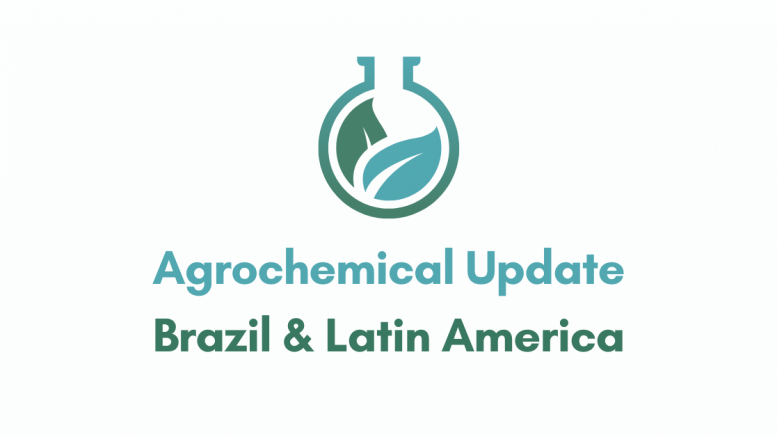“Brazilian soy production is more sustainable than in other countries”
Brazil
In compliance with the court decisions, Anvisa approves toxicological evaluation of indoxacarb 150 g/L EC from Tecnomyl, glyphosate 720 g/kg WG and acetamiprid+ bifenthrin from CHDS, fluroxypyr-meptilic acid from Cropchem and flumoxazin 480 g/L SC from Solus. (Anvisa)
Embrapa-Soja creates a low-carbon seal to recognize farmers who use sustainable technologies. According to company data, mechanized operations using diesel and the use of pesticides and chemical fertilizers generate around 400 kg of CO2 equivalent per ton of produced grain. Adopting the Low Carbon Soy program practices, emissions can be reduced by up to 50%. “It is worth to highligh that Brazilian soy production, even in the modal production system, is more sustainable than in other countries”, said Marco Antonio Nogueira, a researcher at Embrapa. (Embrapa-Soja)
The Government of the State of Paraná and the Consulate General of Hungary in São Paulo enter into a partnership in innovation and technology areas. The objective is to bring together government institutions and companies from both countries to evaluate potential cooperation, especially in agribusiness and chemical products. (Government of the State of Paraná)
Anvisa approves toxicological evaluation of a new formulated pesticide (active ingredient not yet registered), mandestrobin 430 g/L SC, from Sumitomo. Anvisa also approved the toxicological evaluation of a new microbiological product (microbiological active ingredient not yet registered) based on Pseudomonas fluorescens, strain cct 7997, from Solubio, and new biochemical products (biochemicals active ingredients not yet registered), Folcisteine from Nortox and Peptide Flg22-Bt from Syntech. (Anvisa)
Guilherme Galvão da Silva is the new marketing director of Ourofino Agrociência. (Ourofino Agrociência)
Uncertainties in the corn off-season can impact input consumption. According to the Rabobank report on agribusiness, farmers’ uncertainty results in postponing the acquisition of inputs in the expectation that there will be a reduction in input costs or an improvement in commodity prices, and, despite the high stock of products, the delay in acquisition can entail risks for farmers. “The last months of the year will be very important for defining the consumption figures for inputs, especially the number of fertilizer deliveries. If the situation for corn improves, we still have a chance for a strong recovery in deliveries after the decline seen in 2022,” according to the report. (Raboobank)
Experiments with formulated product based on flubendiamide 222, from Sipcam Nichino, show a control effectiveness of up to 99% of the pest Spodoptera frugiperda in corn compared to farmers’ standard treatments. The insecticide stood out for its contact and ingestion effect, and for its ability to penetrate corn leaves. It also presented high selectivity in relation to natural enemies, favoring Integrated Pest Management. (Sipcam Nichino)
Alessandro Gazzinelli is the new field marketing director at BASF Brasil. (BASF)
The Public Ministry of Labor (MPT) went to court to ask Anvisa to cancel atrazine registration in Brazil. The active ingredient is a herbicide and is present in 5% of pesticides sold in the country. With this, the Ministry hopes to inhibit the production, export, import, sale and usage of pesticides with the active ingredient. Atrazine was banned in the European Union in 2003, because the levels found in the water were not considered safe, despite being lower than those found in Brazil. (MPT)
Gustavo Bastide Horbach is the new CEO of Fertilizantes Heringer. (Fertilizantes Heringer)
On October 5th, the General Investigations Department of Jaú seized a clandestine pesticide laboratory in Barra Bonita, State of São Paulo. The warehouse used to produce and counterfeit products. The Civil Police reported that around 200 gallons of fake, expired, or adulterated pesticides were seized. Utensils used in bottling and packaging were also seized. (DIG)
The cotton fallow waiting period came into force this week in the State of Mato Grosso, in accordance with Normative Instruction No. 001/2016. In order to comply with the phytosanitary measure, the state was divided into two regions, the first of which will have a sanitary break period between October 1st and November 30th, and the second, between October 15th and December 14th. (Indea; Sedec)

Latin America
Scientists from the province of Santa Fé, in Argentina, developed bioinputs and biological preparations to use in agriculture. Reconquista biofactory is a bioinput production center that seeks to supply family farmers in the region that produces in an agroecological way or are in the transition process. “The products we manufacture are intended for our own use within the INTA Reconquista Experimental and we also test them with regional producers,” commented Federico Pognante, specialist in Agroecology at the Secretariat of Family Agriculture of the Ministry of Agriculture. (FAO)
Biological engineering students at the National University of Colombia, in La Paz, produced a bioinput based on eucalyptus and neem (Azadirachta indica) as an alternative to the application of fungicides against rust in coffee crops. (National University of Colombia)
National Federation of Coffee Growers of Colombia (FNC) launched technology based on geographic information that reduced crop disease levels. The tool, which uses Esri’s ArcGIS technology, allows coffee farmers to monitor the harvest, in addition to FNC’s constant monitoring of the phytosanitary status of more than 4 billion coffee plants planted on around 658 thousand coffee farms.
Tobacco growers in Cuba who produce above 1.4 t/ha will receive incentives and will be rewarded with 50% of the amount paid in fertilizers and pesticides. (Tobacco Collection and Processing Company Sancti Spíritus)

READ MORE:

